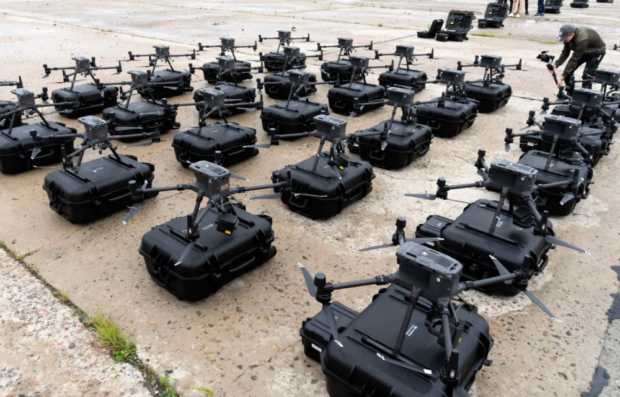A new assessment of Russia’s military capabilities on the front line estimated that its forces were taking down about 10,000 Ukrainian drones every month. Electronic warfare is a “critical component” of Russia’s tactics and contributing to the staggering losses of Ukrainian unmanned aerial vehicles, commonly known as drones, a report released Friday by the UK’s Royal United Services Institute found.
The figures — which amount to more than 300 drones a day — were attributed to three unnamed Ukrainian officers interviewed in April and May.
Russian electronic warfare (EW) remains potent, with an approximate distribution of at least one major system covering each 10 km of front. These systems are heavily weighted towards the defeat of UAVs and tend not to try and deconflict their effects. Ukrainian UAV losses remain at approximately 10,000 per month. Russian EW is also apparently achieving real time interception and decryption of Ukrainian Motorola 256-bit encrypted tactical communications systems, which are widely employed by the Armed Forces of Ukraine.
The report did not specify which models comprised the claimed losses or in what proportion, but James Patton Rogers, a University of Southern Denmark war-studies professor and drone expert, told Insider the majority of those being lost were relatively cheap, small commercial drones used for surveillance.
The estimations indicate the unprecedented scale at which UAVs are being used in Ukraine, he said, adding that this was “one of the world’s first drone vs. drone conflicts.”
Patton Rogers said that while the figures were likely overestimated, they underlined just how effective Russia’s electronic warfare had become at countering Ukraine’s extensive use of drones.
The RUSI report said that along the roughly 750 miles of the conflict’s front line, Russia maintained a major electronic-warfare system roughly every 6 miles. These are set back about 4 miles from the front and focused mainly on neutralizing drones, the report said.
Sophisticated Russian systems such as the Shipovnik-Aero jamming station are hard to detect and can imitate other signals, the researchers said.
“It also has a sophisticated range of effects for downing UAVs,” they said, including interfering with navigational systems.
Ukraine fields a wide variety of drones, from small, commercial-grade UAVs often used for reconnaissance or as loitering munitions, up to the multimillion-dollar Bayraktar TB2, capable of taking out Russian tanks.
Drone warfare was a celebrated aspect of Ukraine’s early success in holding back the Russian advance, prompting an official fundraising campaign — United24 — which was created to form a “drone army.”
But by summer, it was clear that Russia’s electronic-warfare and air-defense capabilities had ramped up, Insider’s Alia Shoaib reported.
Frontline drone operators told The Guardian in April that one of the most popular models — the DJI commercial drone — was rapidly losing its effectiveness.
Nonetheless, Patton Rogers said, Ukraine is developing “its own resilient drone systems to fill this gap in capacity.”
Overall, the RUSI researchers said that after the Russian army’s “disaster” of a performance at the outset of the invasion, it had adapted to Ukraine’s pushback, even as it continued to struggle with poor morale and effective use of heavy armor and air-force attacks.
“The result is a structure that becomes better over time at managing the problems it immediately faces but also one that struggles to anticipate new threats,” the report said.
Sources: RUSI; Business Insider

